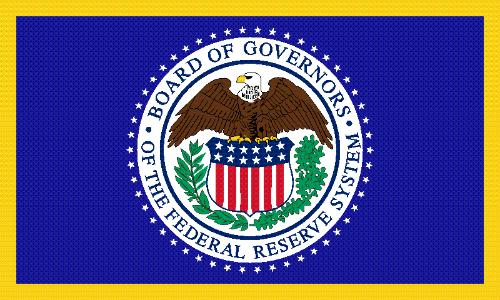Something about the Federal Reserve
美聯儲的臺前幕后
The Federal Reserve System (also known as the Federal Reserve, and informally as the Fed) is the central banking system of the United States. It was created in 1913 by the enactment of the Federal Reserve Act, largely as a response to a series of financial panics or bank runs, particularly a severe panic in 1907. Over time,the roles and responsibilities of the Federal Reserve System have expanded and its structure has evolved. Events such as the Great Depression were some of the major factors leading to changes in the system. Its duties today, according to official Federal Reserve documentation, fall into four general areas:
聯邦儲備系統(人們常說的美聯儲)是美國的中央銀行系統。該系統于1913年根據美國的聯邦儲備法案而建立,主要用于應對一系列的金融恐慌和銀行擠兌,特別是在1907年發生的嚴重的金融恐慌。隨著時間的推移,美聯儲的職責也得到了擴大并且其結構也已經改進。像30年代大蕭條這樣的事件是促使系統改變的主要因素。美聯儲如今的職責,根據官方的聯邦儲備文件規定,可以分為以下4個大部分:
1. Conducting the nation’s monetary policy by influencing the monetary and credit conditions in the economy in pursuit of maximum employment, stable prices, and moderate long-term interest rates.
1. 執行國家的貨幣政策,通過改變經濟的貨幣及信用情況以求最大程度地增加就業率,保持物價穩定和長期穩定的利率。
2. Supervising and regulating banking institutions to ensure the safety and soundness of the nation's banking and financial system and to protect the credit rights of consumers.
2. 對銀行機構進行監管和規范,以保證國家銀行業和金融系統的安全和穩定,并保護消費者的信用權利。
3. Maintaining the stability of the financial system and containing systemic risk that may arise in financial markets.
3. 保持金融系統的穩定以及控制可能在金融市場出現的系統性風險。
4. Providing financial services to depository institutions,the US government, and foreign official institutions, including playing a major role in operating the nation’s payments system.
4. 向美國政府和國外的官方機構等儲蓄機構提供金融服務,包括在國家支付系統的經營中扮演主要角色。

The Federal Reserve is regarded as a quasi-public banking system, since it has aspects of both a government run system and private enterprise. According to the Federal Reserve, there are presently five different parts of the Federal Reserve System:
美聯儲被認為是一個私營的公共銀行系統,因為它即擁有政府運營的部分又有私人企業管理的部分。就美聯儲而言,主要可以分為5個不同部門:
1. The presidentially appointed Board of Governors of the Federal Reserve System, a governmental agency in Washington D.C.
1. 由總統直接任命的聯邦儲備委員會,這是位于華盛頓特區的政府機關。
2. The Federal Open Market Committee (FOMC), which oversees Open Market Operations, the principal tool of national monetary policy.
2. 聯邦公開市場委員會,負責監管公開市場的操作,是國家貨幣政策的主要工具。
3. Twelve regional privately-owned Federal Reserve Banks located in major cities throughout the nation, which divide the nation into 12 districts, acting as fiscal agents for the US Treasury, each with its own nine-member board of directors.
3. 12個分布在全國主要城市的私有聯儲分行將美國分為12 區,每個分行都有9個理事會委員,其職能為美國的財政中介。
4. Numerous other private US member banks, which subscribe to required amounts of nontransferable stock in their regional Federal Reserve Banks.
4. 眾多的其他美國私人銀行,其中每家銀行須向當地的美聯儲分行捐贈規定數額的非轉移性股票。
5. Various advisory councils.
5. 各種咨詢委員會。
The structure of the central banking system in the United States is unique compared to others’ in the world, in that an entity outside of the central bank creates the currency. This other entity is the United States Department of the Treasury.
美國中央銀行體系的構造相較于其他國家的而言是非常獨特的,因為獨立于中央銀行之外還有一個制造貨幣的機構,那就是美國的財政部。
Under the dollar reserve standard, the US dollar was the most favored currency for nations of the world to use as reserves, which continued as dollar reserve standard, the 1970s became a period of high inflation. As a result, in July 1979 Paul Volcker was nominated by President Carter as Chairman of the Federal Reserve Board. He tightened the money supply, and by 1986 inflation had fallen sharply. In October 1979 the Federal Reserve announced a policy of "targeting" money aggregates and bank reserves in its struggle with double-digit inflation.
在美元儲備標準之下,美元曾經在全球各地最受歡迎的儲備貨幣,并且這一趨勢持續了30多年。在美元儲備標準建立之初,20世紀70年代成為了通貨膨脹較嚴重的一段時期。因此,1979年7月總統卡特任命保羅·沃爾克為聯邦儲備委員會主席。他緊縮了貨幣的供應,到1986年通貨膨脹率急劇下降。1979年10月,美聯儲宣布一項“目標”資金總量政策并且銀行儲備系統也在兩位數的通貨膨脹率下苦苦掙扎。












